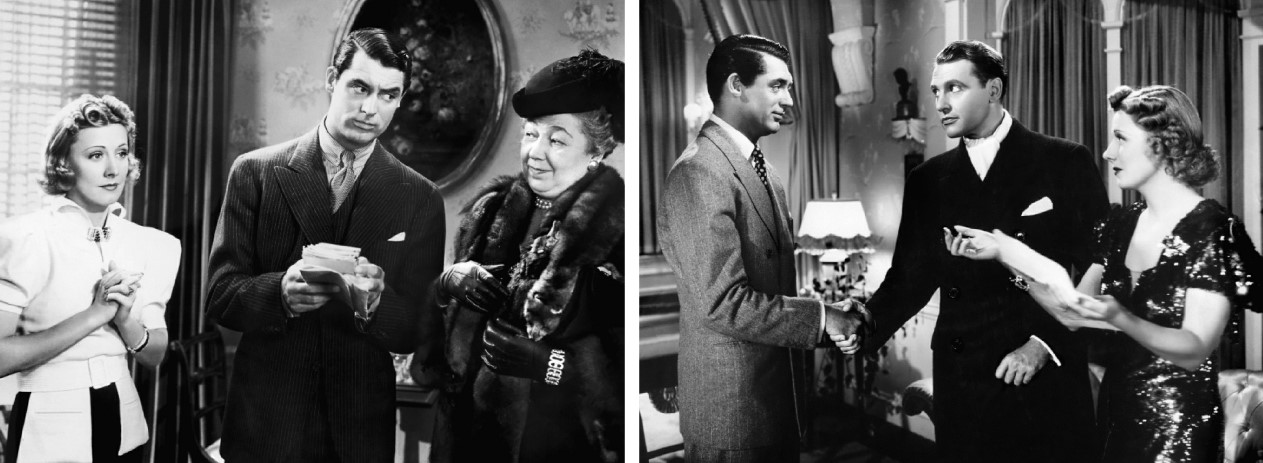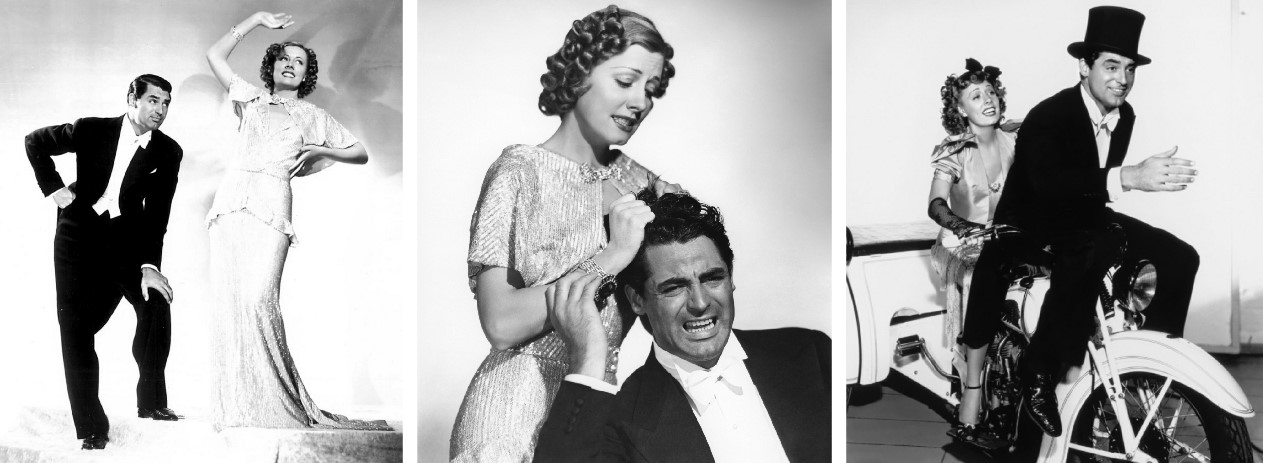The Cary Grant Blogathon: «The Awful Truth» (1937)
Directed by Leo McCarey, The Awful Truth (1937) opens with Jerry Warriner (Cary Grant) at his New York City's men club getting a sun lamp tan. He is supposed to have taken a solo vacation to Florida, but he really stayed in the city to play cards with his friends. When he arrives home, Jerry finds his wife, Lucy (Irene Dunne), coming in with her handsome French voice teacher, Armand Duvalle (Alexander D'Arcy), with whom she was forced to spend the night in the country after his car — so they claim — unexpectedly broke down. Lucy then notices that the Florida oranges Jerry has gifted her are actually stamped «California,» leading her to believe that her husband is lying. Mutual suspicions inevitably result in divorce.
 |
| Irene Dunne, Cary Grant, Esther Dale and Ralph Bellamy in The Awful Truth. |
During the divorce proceedings, Lucy moves in with her Aunt Patsy (Cecil Cunningham), who introduces her to their neighbour Dan Leeson (Ralph Bellamy), a presentable and eligible Oklahoma oil man. Lucy and Dan are instantly attracted to each other and soon announce their engagement, which Jerry resolves to break up. However, when Dan's mother (Esther Dale), who is opposed to the engagement, starts spreading gossip about Lucy, Jerry comes to her defense.
Through a series of events, Lucy and Dan do separate, but by that time Jerry has got involved with heiress Barbara Vance (Molly Lamont). To break up this relationship, on the night before the final divorce decree, Lucy crashes a party at the Vance mansion, posing as Jerry's sister. She pretends to get drunk, parodies the risqué musical number of one of Jerry's former girlfriends and insinuates that «their» father had been a gardener at Princeton University, not a student athlete as Jerry had claimed. Realizing that his chances with Barbara have been effectively sabotaged, Jerry drives Lucy away in her car. Determined not to lose Jerry, Lucy tricks him up to Aunt Patsy's cabin, where they are happily reconciled just before the clock strikes midnight.
Lucy Warriner: You've come home and caught me in the truth, and it seems there's nothing less logical than the truth.
The son of a promoter of prize fights in California, Leo McCarey tried everything from boxing to mining to practicing law before entering the film industry as a writer in 1918. Five years later, he was hired to work at the Hal Roach Studios, where he supervised, wrote and directed several silent shorts starring comedic duo Stan Laurel and Olivier Hardy. With the coming of the sound era, he signed with Paramount Pictures and focused on feature-film directing, achieving great success with Duck Soup (1933) and Ruggles of Red Gap (1935).
Following a failed attempt at resurrecting Harold Lloyd's career with The Milky Way (1936), McCarey directed the unsettling Depression-era family tragedy Make Way for Tomorrow (1937), the personal favourite of all his movies. Despite opening to positive reviews from critics, the film performed poorly at the box-office, prompting Paramount head Adolph Zukor to drop McCarey's contract. At the same time, Columbia chief Harry Cohn was looking for a replacement for Frank Capra, who had left the studio after being denied a salary raise. An admirer of McCarey's comic talents, Cohn immediately signed the director and assigned him to a follow-up to Theodora Goes Wild (1936), a movie that revealed the until-then undiscovered comic talents of Irene Dunne and earned her a second Academy Award nomination.
 |
| LEFT: Leo McCarey c. 1930. RIGHT: Cary Grant and Leo McCarey on the set. |
One day, McCarey ran into Cary Grant on the corner of Vine and Melrose in Hollywood and discovered the actor, too, had just been dropped by Paramount. But neither knew the other had joined Columbia until that studio decided to pair Grant with Dunne under McCarey's direction. They handed McCarey a script based on a 1922 Broadway play by Arthur Richman titled The Awful Truth. The story had been filmed twice before: first in 1925 as a silent feature starring Agnes Ayres and Warner Baxter, and then in 1929 as a sound picture directed by Marshall Neilan for Pathé, starring stage veteran Ina Claire. The man who purchased the rights to the latter version, D. A. Doran, had become an executive at Columbia, which had bought Pathé's scripts after that company folded. Cohn believed in recycling «sure things,» as he liked to call remakes, because he thought it gave his pictures «better odds.» When he found The Awful Truth among the Pathé scripts, he commissioned an updated version that he could make inexpensively.
 |
| Cary Grant and Irene Dunne in publicity stills for The Awful Truth. |
After reading the original Pathé script for The Awful Truth, McCarey promptly threw it in the trash and rewrote it from beginning to end with the help of his friend and occasional collaborator Viña Delmar, who had written Make Way for Tomorrow. He retained the basics of the original play, which centered around an estranged husband's doubts over his wife's relationship with another man, but dropped almost all of the plot incidents, which dealt with mining interests, a fire in an apartment building and a midnight assignation at a luxurious mountain camp.
During the making of The Awful Truth, Cohn had not bothered to assign an office to McCarey — he did not believe directors needed such «extravagances» — so the director was forced to do the majority of his daily rewrites by hand in the front seat of his car, with Delmar sitting next to him on the passenger side, scribbling down pages of dialogue in pencil. Then after trying out that day's pages, they kept what worked with the actors and rewrote what did not for the next day's shoot. This was a directing style that Grant particularly loathed, as he preferred to work from a completed script and rehearse his fixed lines with the other cast members several times until «he had nailed every detail of his verbal and physical performance in advance.»
 |
| Ralph Bellamy, Cary Grant and Irene Dunne in The Awful Truth. |
Because Grant's pre-set approach as so radically different from McCarey's improvisational style, it did not take long for the two to clash. On the first day of filming, someone handed him a series of notes handwritten on scraps of brown paper bag. Grant, as he read what McCarey wanted to get from him that day, thought the director was joking. When none of the routines seemed to work, the director simply told his actors to «make something up that sounded funny.» Grant was appalled, but said nothing. When the same thing happened the following day, however, Grant abandoned the set and went directly to Cohn's office to express his dissatisfaction. Cohn brushed him off, but the next day Grant returned to ask if he could switch roles with Ralph Bellamy, who had been cast in the supporting role of a wealthy oil heir. He claimed that he was much better suited for that role, but Cohn once again sent Grant on his way.
The day after that, Grant went back again to Cohn, offering him $5,000 in cash as a bribe to be taken off The Awful Truth, on top of which he promised to star in another picture for Columbia — any other picture — for free. Cohn refused the money and again told him to go back to work. Apparently, McCarey became so angry at Grant's attitude that he went to Cohn and said he would double Grant's offer if Cohn would fire the actor. Despite the friction between the two, Grant and McCarey eventually found a way to work together, with the director helping the actor find a way to «use physical humor to portray the essential humanity of Jerry Warriner.»
 |
| Cary Grant, Irene Dunne and Ralph Bellamy in The Awful Truth. |
The Awful Truth premiered on October 21, 1937 at the famed Radio City Music Hall in New York. (This was the first of 28 Cary Grant movies that would open there, a record never broken.) Critical reviews were uniformly positive. Otis Ferguson the The New Republic described it as «a foolishness that doesn't go wrong or strained,» the New York Sun called it «a rollicking comedy that should delight anyone,» TIME magazine deemed it «delightfully effective entertainment,» and The New York Times considered it «an unapologetic return to the fundamentals of comedy [that] seems original and daring!» While still in its first-run release, the film surpassed the half-million-dollar profit mark, making it one of Columbia's all-time box-office hits. At the 10th Academy Awards, The Awful Truth received nominations for Best Picture, Best Actress (Dunne), Best Supporting Actor (Bellamy), Best Screenplay, Best Editing, and Best Director. When McCarey received the directing award (a big surprise, he said), he was rumored to have remarked, «You gave it to me for the wrong picture,» referring to Make Way for Tomorrow, which he considered his proudest achievement.
With the success of The Awful Truth, Cary Grant went from a position of relative unimportance only two years earlier, when he had received less than one percent of the annual votes cast at the Motion Picture Herald poll, to one of the top five male box-office attractions of 1937.
This post is my contribution to The Cary Grant Blogathon hosted by Phyllis Loves Classic Movies. To view all entries, click the links below.






Bravo! Your post is almost better than the film itself. I learned a lot about backstage stories through your post. It was fascinating.
ReplyDeleteI always use the example of when Cary and Irene go to court to fight for the dog's custody - it's my favorite scene!
Kisses!
Le
THIS MOVIE! This was the third Cary Grant film I ever saw but it definitely was the funniest! I just adore the ending- so subtle but racy for the time period! I love love love Cary and Irene and wished they made another movie together!
ReplyDelete..oops I meant to say MORE films together! More than 3 they are so great together!
ReplyDeleteIt seems like Grant was always switching or trying to switch roles in his movies!!
ReplyDeleteThanks for this great behind-the-scenes look of this classic film :)